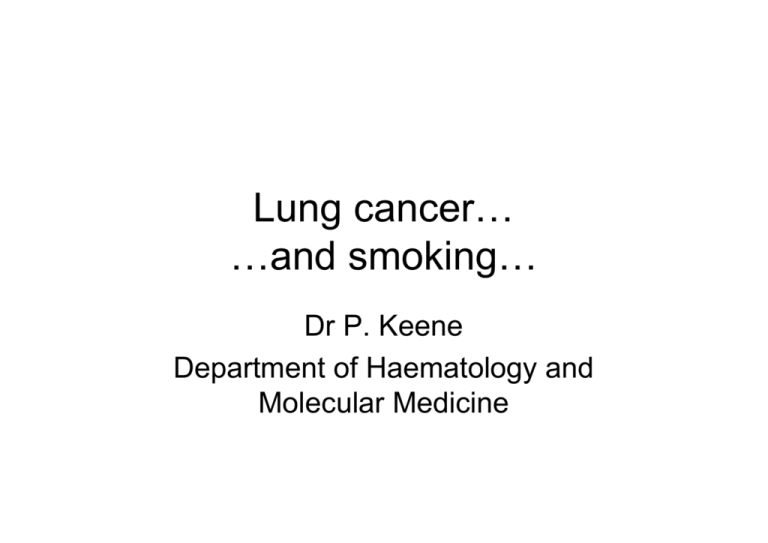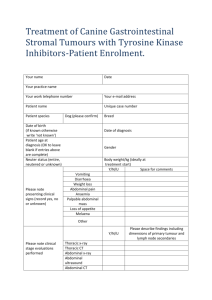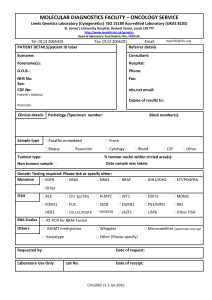Lung cancer Lung cancer… …and smoking…
advertisement

Lung cancer cancer… …and smoking… g Dr P P. Keene Department of Haematology and M l Molecular l M Medicine di i Objectives • Explain the role of tumour initiators and promotors • Relate the known aetiological agents of lung cancer to the initiator and promotor roles • Describe the tumour microenvironment with respect to inflammation • Explain why tobacco smoking has both initiator and promotor properties • Discuss treatment of NSCLC in the molecular era. era Aetiological agents in lung cancer • Smoking S ki But also: • • • • Radon Asbestosis Any lung scarring such as old TB Other In general, there is cell death and tissue injury Occupational causes of lung cancer: Number of attributable lung cancer registrations in 2004 for men and women by carcinogen or occupational circumstance. (Britain) Tumour initiators and promotors • Initiators – cause mutations in DNA • Promotors – factors leading to the proliferation of initiated cells. What roles do the traditional aetiological factors in lung cancer play? • Initiators • Promotors P t • Both Inflammation is now recognised as a critical component for tumour progression It appears pp to be p playing y g a role as a tumour promotor, although some aspects of inflammation act as an i iti t as well. initiator ll Hanahan and Weinberg, 2011: Hallmarks of Cancer: The Next Generation Tumour-promoting inflammation is regarded d d as an essential “enabling characteristic” in tumour formation Background: The Tumour Microenvironment The microenvironment surrounding cancer cells: • Cells – other cancer cells as well as many different non non-cancerous cancerous cells • Extracellular matrix • Soluble factors e.g. g g growth factors,, chemokines, proteases… Non-cancer cells – components of all tumours • All the cells that make up blood and lymph p y etc. vessels – endothelial cells,, pericytes • Cancer-associated C i t d fib fibroblasts bl t • Inflammatory cells – innate and adaptive macrophages ne macrophages, neutrophils, trophils different classes of lymphocytes Cancer associated fibroblasts Cancer-associated Carcinoma cells Fibrous tissue Fibroblasts “Scirrhous” carcinoma of the breast Tumour fibrosis Dense, white fibrotic cancer in a breast Cancer associated fibroblasts Cancer-associated • “N “Normal” l” fibroblasts fib bl t • “Myofibroblasts” – contain actin. They secrete many enzymes which remodel the microenvironment e.g. matrix metalloproteinases, as well as the collagen and other constituents of the ECM. They are responsible for contraction of wounds d Their importance has been demonstrated in transplantation p experiments p Inflammatory cells as part of the microenvironment Morphologically this has been recognised for centuries – Virchow,, 1863 The importance of these cells is now appreciated but the exact mechanisms of interaction between them and tumour are only beginning to be understood. Inflammatory y cells These occur in varying proportions in almost allll cancers Cancer‐ promoting effects ff Cancer‐ inhibiting effects ff Macrophages Macrophages p g Inflammatory cells in cancer Arrow: cancer cells Arrowhead: lymphocytes Arrowhead: lymphocytes The Cancer-Inflammation Relationship • Inflammatory cells foster proliferation, survival and migration of the cancer cells • Cancer cells use inflammatory signaling molecules l l and d receptors t ffor migration, i ti invasion and metastasis I early In l tumour t growth th the th tumour t cells ll are dependent on the inflammatory cells in the microenvironment. In late tumour g growth many yp proinflammatory factors come under control of tthe e tumour tu ou ce cells s tthemselves e se es e.g. COX-2 is produced by stromal cells in early tumours, tumours but by cancer cells in later tumours. Chemokines are central central… • Tumour cells appear to secrete chemokines themselves or induce their secretion by stromal cells, thus recruiting inflammatory cells • Some tumour cells use chemokines in autocrine control off their own growth – this has been shown in NSCLC – as well as those produced by inflammatory cells Back to smoking… smoking Smoking S ki appears tto be b such h a powerful f l cause off lung cancer as it contains both initiators and promotors. promotors Smoking is a cause of INFLAMMATION as well as containing carcinogens The cancer risk Th i k reduces d in i smokers k who h quit it b butt it does not return to normal - because of the reduction in inflammation? Inflammation as a carcinogen The microbicidal mechanisms of neutrophils p g involve the g generation and macrophages of reactive oxidant species ROS are capable of directly causing DNA damage Smoking related damage in the lung is not confined to the tumour… tumour 2 The future of treatment in non small cell lung cancer: Molecular pathology gefitinib/ erlotinib cetuximab trastuzamab crizotinib 2





